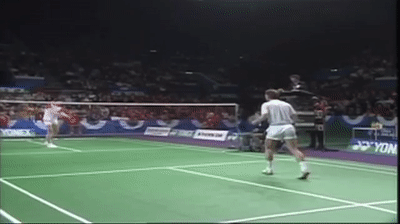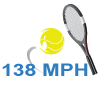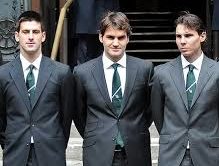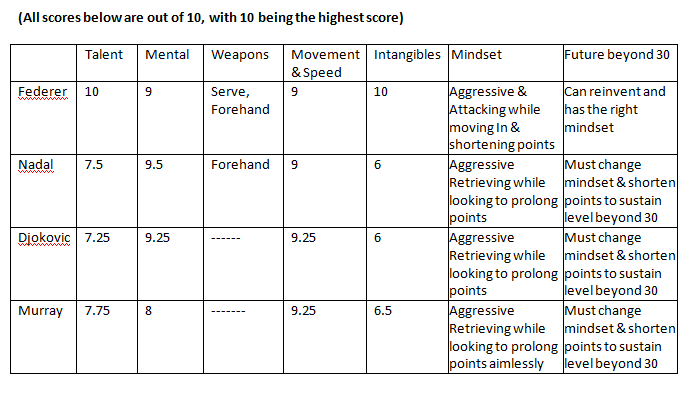Decoding the BIG three & Murray – The Intangibles
As stated in earlier posts of this series, the INTANGIBLES probably have a profoundly tangible effect on longevity and performance after the 30th birthday of a player.
It’d be impossible to go over the entire list, if there is such a list somewhere, of intangibles; however, I’ll try and include some of those that come to my mind and I consider important enough to merit not only your time but also some space here.
So, what can be classified as intangibles in tennis played at its highest level today? In my humble opinion these are those little, inconspicuously obvious traits in a player’s game which, if present, are glaringly evident to even an average Joe or Jane who watches tennis only once in a while and cannot possibly be classified as an ardent fan of the game.

A non tennis related example that comes to my mind is when, upon repeated insistence of my good friend Kevin Wu, I checked out Zhao Zianhua, the top badminton player in late 1980s, play against the Danish badminton player Morten Frost Hansen. My friend wanted me to see how badminton even 30 years ago was a faster and more demanding game than today’s tennis and he sincerely thought that Zhao would probably be the best player of that era to showcase what he believed was the obvious supremacy of badminton over tennis. As an emotionally unattached viewer the only thing that jumped out at me and captured my attention in an instant was Moretn Frost’s smooth, effortless footwork which seemed so much like Roger’s! No other aspect of the match was more glaring than Frost’s effortless footwork, and other facts such as the higher rank and physically superior level of Zhao’s play barely registered.
These, I believe, are some of the intangibles in tennis which deserve a mention.
1. INTANGIBLE: The ability to reinvent the game or important aspects of it.
Federer: He has managed to reinvent his back-hand and return of serve to a point that has helped him beat Nadal three times in a row in 2017 alone, and that was quite unthinkable just 4 months ago. His mindset has played an important part in the process and the eventual outcome but his ability to successfully reinvent at this age is simply amazing. Further, within a match, most players can just about change and reinvent their strategies and tactics but Federer can actually change his shots and the way he hits them! This was at full display during his 2007 US Open encounter against Feliciano Lopez where Lopez was up a set and anticipating every move of Roger quite accurately. So what did Federer do? He not only slowed the pace of the game but also held back from hitting the ball early as is his nature, I was very surprised to see Roger take some balls purposely on the way down even after reaching them early enough to execute half-volleys. Within a few games thereafter Lopez’s perfect anticipation became somewhat imperfect and Federer then reverted to his usual, take no prisoners, aggressive self. An entire book of no less than 150 pages can be devoted to Roger’s ability to reinvent his game but this should suffice for the time being.
Nadal: Rafa can certainly reinvent his game and in 2017 he has been trying to play closer to the baseline and take the balls early. He even tried to change his serve in the past and added considerably to his serve mph back then. However, unless re-invention comes naturally and comfortably it usually falls by the way side when faced with adversity or pressure because in the very end we all like to do what comes naturally to us.
Djokovic: Reinvention may not come naturally to him but it certainly happens quite often. Djokovic will do whatever it takes to be the best and usually that is enough to get results. However, just like with Nadal, it crumbles under adversity and too much pressure. For example, Novak’s efforts to move to the net are commendable but they do not last long enough to break a quality opponent down like his natural game.
Murray: Yes he can change his game as required and has done it too. Technically he is as good with an aggressive as with defensive style of play but his mindset is not aggressive so he automatically reverts to defensive mode unless someone like Lendl can force or inspire him to play seven matches in a row aggressively.
2. INTANGIBLE: The ability to play as comfortably at or inside the baseline as five feet behind it.
Federer: Is Roger comfortable playing from inside the baseline? I say, make the courts super fast and Roger will probably never go outside of it! He grew up in the era of fast courts and serve and volley and by his own admission was quite lazy during practice as a teenager and therefore quite happy hitting half volleys in no man’s land instead of making the effort to retreat behind the baseline.
Nadal: I find it very hard to imagine that Nadal would actually be comfortable playing inside the baseline for any extended period of time. Can he do it? Sure he is talented enough to play inside the baseline and even approach the net deftly but he is not comfortable at it.
Djokovic: Yes he has the talent to play inside the baseline but like Nadal he is certainly not comfortable doing it. However, like with everything else he can easily will himself and practice hard enough to become quite good at it.
Murray: Andy is quite comfortable playing inside the baseline as he is 10 feet behind it, but will he actually do it when required?
3. INTANGIBLE: Comfort with hitting half-volleys, which goes beyond and above the ability to take the ball on the rise.
Federer: If you are comfortable playing inside the baseline then the nature of that beast would require you to be adept at half volleys and that rule applies to Roger.
Nadal: Rafa would probably prefer taking full cuts at the ball instead of hitting half volleys and with his super charged forehand no one can really blame him for it.
Djokovic: Novak too is not a major fan of half volleys and in fact both Novak and Rafa probably consider half volley an outcome of bad footwork, which is not entirely incorrect.
Muray: He is perhaps the only other in this analysis who might not be overly concerned about hitting too many half volleys. However, will Murray ever use that to his advantage and for winning points? I doubt it.
4. INTANGIBLE: Comfortable at approaching the net.
Federer: Roger is very comfortable at approaching the net and has an instinctive grasp of the court geometry when doing so. He may lose a quarter of a step with age and may not be as good in a few more years but he will still be comfortable at it.
Nadal: Rafa is very good and also appears to be quite comfortable at approaching the net but simply doesn’t make enough trips to that zone.
Djokovic: Novak needs considerable work in that aspect of his game and is just not a natural like Roger and Andy.
Murray: Is also good at approaching the net but like with everything else he just doesn’t involve himself with the good stuff that can win him a lot more slams
5. INTANGIBLE: Making it look easy!
This is a crucial element of the “Intangibles” category because all of the aforementioned intangibles and many others, such as balance and more, actually blend together to create a game that appears effortless to a viewer or spectator. And, this category is ruled by Roger alone. Whether at the net or baseline Roger makes it look so easy. He inspires normal people to pick up a racket because watching him makes them believe in their untested ability to execute something similar. After all, how hard can it be if this dude on their screen seems to be gliding through it without breaking a sweat?
Rogers makes it look easy because he is not out of place or his natural elements while executing his shots and therefore he is a master of those intangibles and the proof is in the pudding that he has been having lately!
Roger is a vast reservoir of these so called intangibles, and these very intangibles, hopefully for a couple more years, will continue to make up for the inevitable decline in speed, stamina and explosiveness, and slowing down of reflexes.
Will the current crop of players be able to raise their level enough to blunt Roger’s advantage of intangibles? We shall soon find out.
I invite your comments and suggestions below on intangibles which you feel should have also been included.
This post is a continuation of the following:



wow
what about wowrinka 🙂
I prefer “The Big 5” to acknowledge the accomplishment of Stan.
Another interesting piece. I am not sure whether I agree or disagree with the post. Like the badminton analogy.
Like all great things must come to an end, this series too had to end. The blogger has done a great job breaking down a variety of aspects in the game of Big Four. Ideally I believe there is no such thing as Big Four. Big Three Yes.
I would agree with your insights/ perspective on Roger’s intangibles. He really is in a league of his own isn’t he (10 out of 10) is fair. I hope the FED will keep up this level of tennis for a least a couple more years. It has been and continues to be (nothing short of) a miracle in tennis.
I believe a significant amount of shots, game play and strategy used by successful players in todays game have been a copy or reflection of Rogers shots that kept him at the top for so long. He makes shots as they are needed, not because hes practiced it. And even today, no one comes even close to matching that skill with the racket, that understanding of the court limits and the overall position of the game. Its what makes him the GOAT.
Rafa is a great player (and if there was no Roger, i would be a rafa fan) but its very rare to see him come up with an inventive shot in a high pressure game. Novak would be even less adept at it than rafa is. I wont comment about Murray.
This separates Roger from almost any player on the planet. This ability to invent his point, his game.